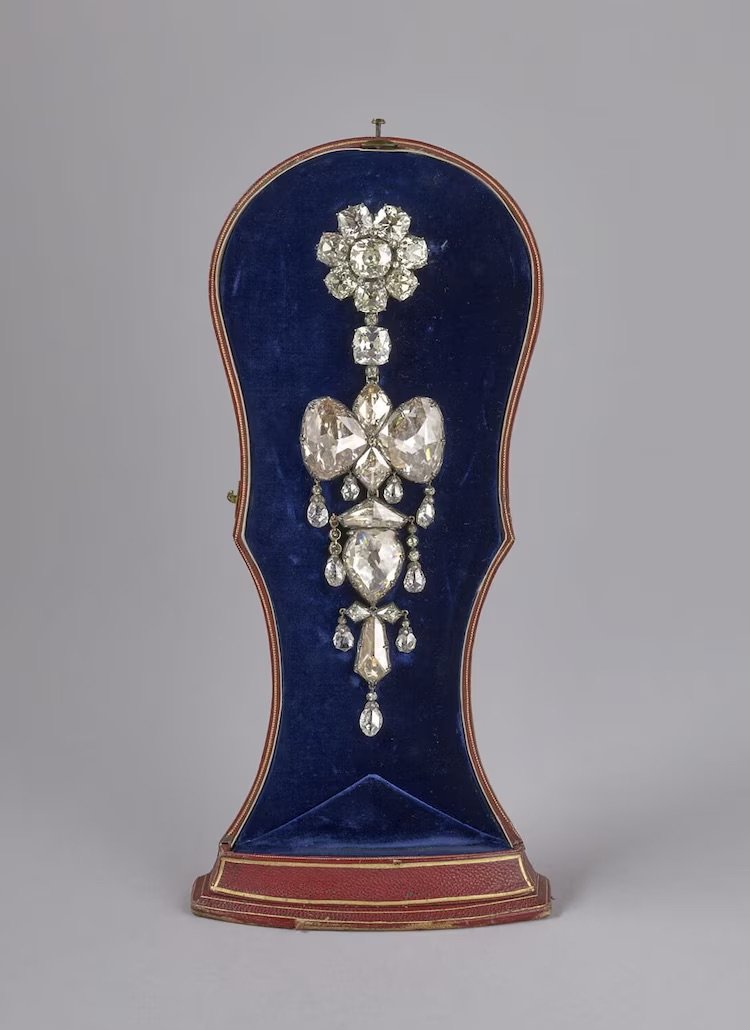Napoleon-Era Imperial Jewels Stolen from the Louvre — The Loss of French Heritage
Eight jewels from Napoleon’s imperial court were stolen from the Louvre in Paris — a theft that reignites global fascination with their extraordinary craftsmanship and place in French history.
Empress Eugénie’s pearl diadem on display inside the Louvre’s Galerie d’Apollon — one of the jewels linked to France’s imperial history.
© Maeva Destombes/Hans Lucas/AFP/Getty Images
Centuries of imperial brilliance have vanished from the heart of Paris. Among the treasures stolen from the Louvre’s Galerie d’Apollon were jewels once worn by Napoleon’s empresses — creations that embodied the splendor, artistry, and ambition of 19th-century France. Today we look closer at the jewels themselves: their craftsmanship, their symbolism, and why their loss feels like a wound to French heritage.
The Louvre Lost Its Crown Jewels
On Sunday, October 19, a group of thieves entered the Galerie d’Apollon, home of France’s historic crown jewels. Disguised as maintenance workers, they forced a high window, broke into two display cases using power tools, and escaped within minutes on motorbikes through the Tuileries Gardens.
Authorities confirmed that eight jewels — all of Napoleonic provenance — were taken. The museum’s alarms triggered immediately, but the thieves had already disappeared into central Paris traffic.
The French Ministry of Culture described the event as “an attack on a heritage that belongs to every citizen.” The Louvre remained closed the following day as security teams and historians assessed the damage. One crown attributed to Empress Eugénie was recovered nearby, dropped during the escape — a single piece of fortune in an otherwise devastating loss.
Empress Marie-Louise’s Emerald Necklace and Earrings
© Frédéric Souloy / Gamma-Rapho via Getty Images
Commissioned in 1810 to celebrate Napoleon’s marriage to Marie-Louise of Austria, the emerald parure was a wedding gift that embodied both imperial ambition and sentimental devotion. Created by court jeweler Nitot, the necklace and earrings featured luminous Colombian emeralds framed by diamonds — each stone carefully chosen to mirror the regal green of the empire’s crest.
Marie-Louise wore them in official portraits, where their brilliance softened the austerity of her imperial attire. More than symbols of wealth, these jewels represented a fragile hope for dynastic continuity after Napoleon’s tumultuous reign. Their theft severs one of the last tangible links to that era — when jewels were not mere adornments but declarations of power and destiny.
Empress Eugénie’s Pearl and Diamond Diadem
Created around 1853 for Empress Eugénie, the wife of Napoleon III, this diadem captures the height of Second Empire refinement. Designed by Eugène Fontenay, it was conceived as a balance between grandeur and grace — each natural pearl rising like a droplet of light, encircled by brilliant-cut diamonds that ripple with subtle fire.
Eugénie adored pearls, calling them “the tears of the moon,” and wore this diadem at court receptions and portraits that defined imperial fashion. To 19th-century France, she represented the modern empress — elegant yet independent, a patron of both couture and craftsmanship.
Now missing from its glass vitrine, the diadem’s absence feels haunting. It was more than jewelry; it was an emblem of the refinement that once placed Paris at the center of the world’s imagination.
Empress Eugénie wearing her magnificent Pearl Tiara, portrayed by the celebrated artist Franz Xaver Winterhalter in 1853, shortly after her marriage to Napoleon III.
Sotheby’s specialist presents Empress Eugénie’s Pearl Tiara ahead of its 1992 auction in London — a landmark sale that marked the tiara’s reappearance on the market following decades in private hands.
The Sapphire Parure of Queen Marie-Amélie and Queen Hortense
Diadem from the sapphire parure of Queen Marie-Amélie and Queen Hortense, on display at the Louvre Museum, Paris.
© Musée du Louvre, Paris / Wikimedia Commons (CC BY 2.0)
In the opulent salons of 1840s and 1850s France, sapphires became the jewel of choice for courtly display — and none exemplified this better than the parure worn by Queen Marie-Amélie and her step-daughter Queen Hortense. The set — a tiara, necklace and single earring — paired deep royal-blue sapphires with scintillating diamonds, evoking both regal sobriety and luminous possibility. Marie-Amélie wore the tiara at the 1830 inauguration of the July Monarchy, while Hortense later adorned the same necklace during diplomatic galas in London. Crafted by Parisian master atelier Chaumet, the jewels spoke of continuity in a France still finding its identity between empire and republic. Their disappearance from the Louvre’s display feels like the loss of a dialogue between generations — a conversation in blue-stones silenced too soon.
The jewels stolen from the Louvre are far more than missing objects — they are fragments of France’s imperial past, each carrying its own story.
Among them was the sapphire jewelry set of Queen Marie-Amélie and Queen Hortense. The tiara, necklace, and single earring once belonged to two generations of royalty, their deep-blue sapphires surrounded by diamonds — timeless symbols of power and refinement. Created by the Parisian maison Chaumet, the set reflected the royal taste of the 19th century and the elegance that defined France’s courts.
Also taken was the emerald necklace and earrings of Empress Marie-Louise, Napoleon I’s second wife. Crafted in 1810 by the imperial jeweler François-Regnault Nitot, the emeralds were gifts from Napoleon himself — tokens of love, triumph, and the glory of his empire. Their vivid green captured the spirit of an era when jewelry was both art and declaration.
From the Second Empire came the treasures of Empress Eugénie — her magnificent pearl tiara, a large corsage brooch, and a reliquary brooch believed to hold a sacred fragment linked to the imperial family. Empress Eugénie’s pieces were more than adornments; they represented her refined style and her influence over 19th-century fashion.
Together, these jewels formed part of the Louvre’s most symbolic collection — each piece a reflection of French history, craftsmanship, and identity. Their disappearance leaves not only empty displays but also a deep sense of cultural loss.








